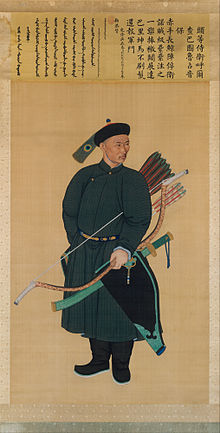Imperial Guards (Qing dynasty)

The Imperial Guards (Chinese: 侍衛; pinyin: shìwèi) of the Qing dynasty were a select detachment of Manchu and Mongol bannermen responsible for guarding the Forbidden City in Beijing, the emperor, and the emperor's family. The Imperial Guards were divided into three groups:[1] the Guard, the Vanguard, and the Imperial Bodyguard.[2]
Guard
The Guard (Manchu: bayara; simplified Chinese: 护军; traditional Chinese: 護軍; pinyin: hùjūn) corps was assigned to protect the imperial palace. Soldiers from the Manchu and Mongol banners could join. The Guard corps was about ten times the size of the Vanguard and Imperial Bodyguard.[2]
Vanguard
The Vanguard (Manchu: gabsihiyan; simplified Chinese: 前锋; traditional Chinese: 前鋒; pinyin: qiánfēng) corps was assigned to march ahead of the emperor when he left the palace. Soldiers from the Manchu and Mongol banners could join. The Vanguard consisted of about 1500 men.[2]
Imperial Bodyguard
The Imperial Bodyguard (Manchu: hiya; simplified Chinese: 领侍衛; traditional Chinese: 領侍衛; pinyin: lǐngshìwèi) corps was assigned to protect the emperor at all times. Only Manchu bannermen could join, and most members came from the upper three banners. Like the Vanguard, the Imperial Bodyguard consisted of about 1500 men.[2]
See also
References
- ^ Rawski 1998, p. 82.
- ^ a b c d Elliott 2001, p. 81.
- Elliott, Mark C. (2001), The Manchu Way: The Eight Banners and Ethnic Identity in Late Imperial China, Stanford University Press, ISBN 9780804746847
- Rawski, Evelyn S. (1998), The Last Emperors: A Social History of Qing Imperial Institutions, University of California Press, ISBN 9780520926790
